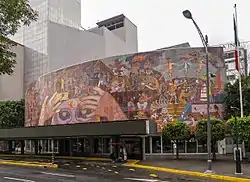 | |
 Exterior of the theatre in 2014 | |
| Location | San José Insurgentes, Benito Juárez, Mexico City |
|---|---|
| Coordinates | 19°21′51″N 99°10′56″W / 19.36417°N 99.18222°W |
| Public transit | |
| Owner | Televisa |
| Operator | Ticketmaster |
| Type | Theater |
| Capacity | 959 |
| Construction | |
| Built | 1953 |
| Opened | 3 April 1953 |
| Architect | Alejandro Prieto |

Teatro de los Insurgentes (English: Theater of the Insurgents) is a theater located on Mexico City's Avenida de los Insurgentes. Opened in 1953, the theater seats 959 spectators.[1]
History
The construction of Teatro de los Insurgentes was funded by José María Dávila in 1953 as part of President Miguel Alemán's program of urban renewal. Architect Alejandro Prieto, chosen by Dávila, was in charge of designing the theater. Dávila commissioned muralist Diego Rivera to paint La historia del teatro, a visual history of the theatre in Mexico on the building's façade. The Marxist artist placed the character of Cantinflas in the center of the mural in the form of a Robin Hood figure, distributing the wealth of the rich to the poor. The mural also references Mexican historical characters like Miguel Hidalgo or José María Morelos.[1][2]
The theater's inaugural performance was Cantinflas' elaborate return to the stage after considerable success in films. The work, Yo, Colón, placed Cantinflas in the role of the Paseo de la Reforma statue of Christopher Columbus, who came to life and made candid "discoveries" about contemporary Mexican society. The play was written by Alfredo Robledo and Carlos León, Federico Ruiz was the music composer and Guillermo Keys-Arenas was in charge of choreographing the show.[3]
In 2005, Rivera's mural was restored, funded by Televisa, owner of the theater.[4][5]
Events
Theater
In 1974, Pippin made its Spanish-language debut at the theater. It was produced by Mexican pop singer Julissa, who also played Catherine. Also in the cast were Burt Rodríguez as Leading Player, Héctor Ortiz as Pippin, Guillermo Rivas as Charles, Anita Blanch as Berthe, and Jacqueline Voltaire as Fastrada.
In 1975 a version of Sugar was produced in the theater. It starred the singer Enrique Guzmán and the actors Héctor Bonilla, Chabelo and Sylvia Pasquel.[6]
In 2022, the Mexican production of Network, featuring Daniel Giménez Cacho, Zuria Vega and Arturo Ríos, debuted in the theater.[7][8]
Sports
Teatro de los Insurgentes was one of the venues of the 1968 Summer Olympics, hosting the weightlifting competitions.[9] In order to host the Olympics, some modifications were made to the theater: a gym was built inside the theater as well as bathrooms, a sauna room and individual locker rooms for the competitors. A giant sculpture of a weightlifter, nicknamed "Judas", was placed on the Avenida de los Insurgentes in front of the venue.[10]
Music
American Latin rock band Santana played in the theater on 24 September 1973, as a part of their Caravanserai Tour.
References
- 1 2 "Teatro de los Insurgentes". Sistema de Información Cultural-Secretaría de Cultura (in Spanish). Retrieved 11 February 2023.
- ↑ "Sobre el mural de Diego Rivera que adorna el Teatro Insurgentes". MXCity (in Spanish). 24 November 2017. Retrieved 11 February 2023.
- ↑ Dallal, Alberto. "Teatro de los Insurgentes". Revista Imágenes del Instituto de Investigaciones Estéticas UNAM (in Spanish). Retrieved 11 February 2023.
- ↑ Mateos-Vega, Mónica (30 November 2005). "Restaurará el INBA el mural de Rivera del teatro Insurgentes". La Jornada (in Spanish). Retrieved 11 February 2023.
- ↑ "Televisa restaurará mural de Rivera". El Universal (in Spanish). EFE. 24 November 2005. Retrieved 11 February 2023.
- ↑ "Sugar". Red Teatral (in Spanish). Archived from the original on 19 September 2019. Retrieved 11 February 2023.
- ↑ "Daniel Giménez Cacho convoca al diálogo con la obra "Network"". El Universal (in Spanish). 30 April 2022. Retrieved 13 February 2023.
- ↑ "Daniel Giménez Cacho, Zuria Vega y Arturo Ríos encabezan Network". Cartelera de Teatro (in Spanish). 1 March 2022. Retrieved 13 February 2023.
- ↑ 1968 Summer Olympics official report, Volume 2. Part 1. p. 78
- ↑ ""Soñé sólo con ir a los Olímpicos, nunca con ganar una medalla"". El Universal (in Spanish). 17 August 2016. Retrieved 13 February 2023.

